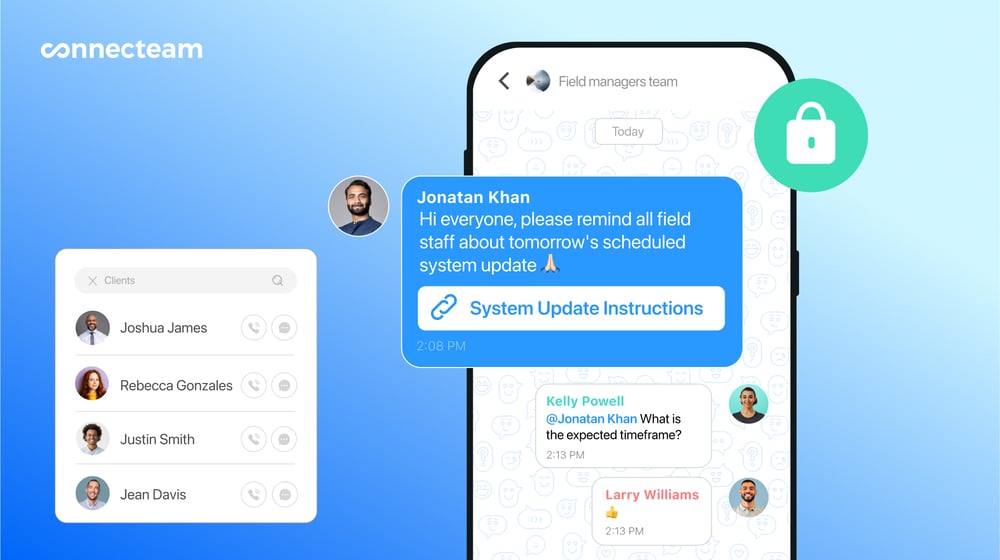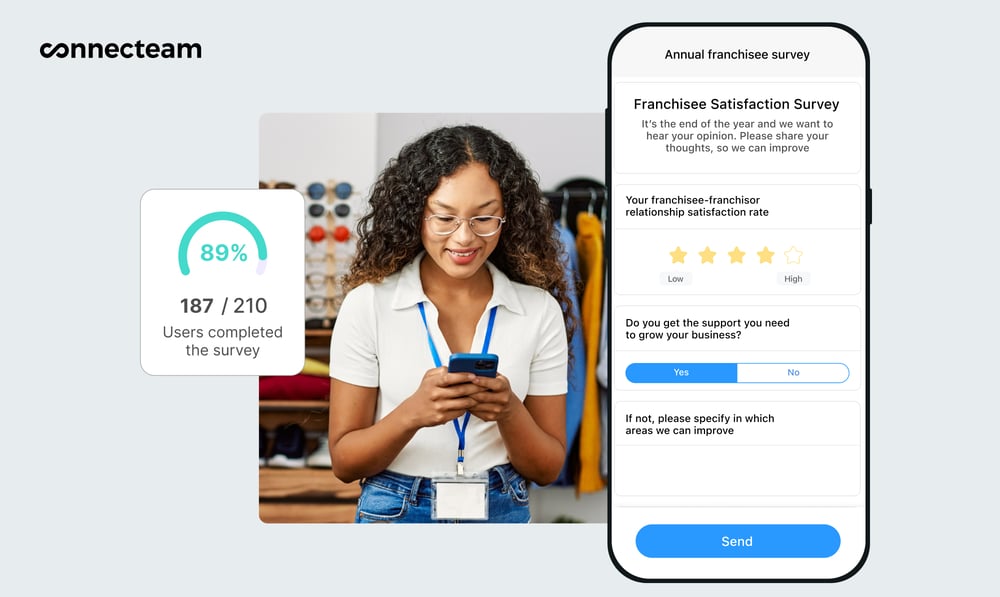Team communication is the crux of a well-functioning workplace. However, effective communication at work isn’t always simple to accomplish. In this article, we’ll be discussing the importance of developing an effective communication strategy and tips for doing so.
All workplaces require information sharing and communication.
Whether it’s offering performance feedback to employees, taking a phone call, attending a team meeting, or sending emails about company updates, 97% of workers say communication affects their work tasks and their ability to do their jobs every day.
So, what are the most effective communication strategies, and how can you apply these at work?
Good communication is about connection and making sure relevant information reaches the right team members at the correct time.
It’s about making sure everyone feels comfortable asking questions and communicating effectively to get their work done, and ensuring that workers feel supported.
Why Improve Communication Strategies at Work?
Effective communication in the workplace is essential for many reasons. First off, it ensures that all employees have the information they need to do their jobs correctly.
It also helps foster positive and friendly relationships in the workplace, which can bolster company culture and employee engagement.
This can all translate to better business outcomes: workplaces that improve communication can see productivity rise by up to 25%.
Obstacles to Developing Effective Communication Strategies
Only 7% of workers polled in the United States agreed that communication at their organization is open, timely, and reliable.
This is a shockingly low number, and it’s important to understand the primary reasons for poor communication in the workplace:
- Hybrid and remote workers: The post-pandemic work environment has resulted in more deskless, hybrid, and remote employees. Currently, about 9% of the workforce works largely remotely, and 11% are fully remote. However, 2.7 billion workers, or about 80% of the global workforce, don’t sit in offices and work from the field. As a result of not being in the same physical location, communication can be much more difficult, and many businesses don’t know how to fix this.
- Different communication needs among team members: Not everyone communicates the same way–some managers may prefer email, while some workers may prefer in-person talks. Communication preferences on a team can vary depending on personality, age, background, culture, and other factors, and it can be hard to satisfy everyone’s preferred communication styles.
- The need for difficult conversations: One big challenge to communication in the workplace is when a manager or leader needs to have a difficult conversation. Whether it’s telling an employee they need to improve their work or laying someone off, conversations with bad news can cause employees to feel disengaged or upset. When this type of communication is not handled sensitively, workers are more likely to feel disengaged or quit.
This Might Interest You
If you’re interested in learning more about communication problems in the workplace, we put together a guide on the most common workplace communication problems and how to solve them.
Fortunately, there are communication strategies you can incorporate to reduce the likelihood of these obstacles standing in your way of
9 Strategies for Effective Communication
Effective communication strategies rely on creating a work environment where information flows smoothly.
Here are 8 ways you can foster effective communication strategies.
Create clear, simple communication channels
If someone on your team needs a specific piece of information, do they know where to go or who to turn to to find it? A good communication strategy begins with clear channels of communication. This may include in-person meetings, chat apps, online knowledge bases or directories, and task management tools.
Next, consider what you need to communicate. Do you need to help team members understand their schedules and shifts? Do you need to offer training and checklists to help workers do their job?

Effective strategies for communication often involve multiple types of interactions. To decide which channels make the most sense for your business, start by pinpointing the communication tools and platforms you currently use and figure out which ones may not be necessary. The more you can streamline the communication process, the more effective it will be.
A solution like Connecteam, for example, lets you chat directly with employees in the app, share updates, create schedules, offer training, and share and store documents in one place. This way, your employees have access to any information they need no matter where they are.
Know your target audience
A well-designed approach to communication hinges on recognizing the preferences, needs, and behaviors of your employees. This is incredibly important to gaining trust and relaying the importance of your message: the more your audience can relate to what you’re saying, the more receptive they’ll be.
Every time you communicate with a team member or group of employees, it will most likely be for a different reason. Therefore, it’s important to understand what each person’s needs are and address them when speaking.
Encourage two-way communication
The best communication strategy is one that involves sharing and good listening skills. Even if your employees don’t all work in the same physical location, take the time to engage employees in meaningful conversations via instant messages and ask for feedback with polls and surveys.

When you are communicating with your team face to face, engage in active listening. This involves being completely present and paying close attention to what the other person is saying. Active listening promotes positive employee engagement and trust amongst your team.
Here are a few tips for engaging in active listening:
- Put away all distractions.
- Pay attention fully, maintain eye contact, and listen to the person speaking.
- Don’t make any inappropriate facial expressions.
- Withhold judgments and avoid interrupting or speaking until the speaker has stopped talking.
- Allow a moment to pass before replying.
- Check in with your body to see whether you are having any reactions, such as a tightening of the shoulders, during the conversation. This can keep you from being reactive. If you notice your body tensing, give yourself an extra moment to breathe and then work to keep the communication pleasant and professional.
- In a calm tone of voice, summarize and clarify the conversation by restating it in your own words. This shows the other party you were paying attention and that you care about their message.
- Introduce your own ideas and responses only once you feel you have understood the ideas and perspectives of the speaker.
Did You Know?
There are 4 primary forms of communication:
- Verbal communication: Speaking face-to-face, on the phone, and via voice notes.
- Nonverbal communication: Nonverbal cues, gestures, and body language.
- Visual communication: Images, videos, and graphics.
- Written communication: Emails, texts, and instant messages.
If your employees don’t work in the same physical location, you may end up using more written and visual communication with your team. No matter what communication tools you use, it’s vital to create an effective communication strategy that allows for two-way communication.
Check in regularly
Communicating effectively isn’t just about how you communicate but also how often. To improve your communication skills, you want to strike a balance: communicate often enough to make employees feel heard, supported, and engaged, but not so often that they feel micromanaged or interrupted.
For everyday information, like training, updates, tasks, and documents, have a dedicated Knowledge Base where everyone can easily find what they need. Every file should be clearly labeled and organized, and be sure to archive or update outdated material so your team only has access to relevant information.
You can also take advantage of an employee management app to regularly check in with your team. Features like private and group chats and a company newsfeed make it easy to send important updates and urgent messages whenever necessary.
If you’re interested in tools to improve communication and team management, check out our in-depth review of the best team management apps available.
Get feedback about company communication
As you build your communication strategy, ask your staff for feedback about their preferred communication styles and what the company can improve on with polls and surveys. Is everyone comfortable with the style of communication, or are there still problems to address? While you may not be able to address everyone’s concerns, if you see a pattern emerge, you may want to make changes.
Pro Tip
It’s important to regularly measure your team communication strategy. Are you seeing fewer mix-ups, less frustration, and more efficiency? Are fewer pieces of information falling through the cracks? To evaluate correctly, read our guide to measuring your company communication.
Use clear, to-the-point, and jargon-free language
There’s no need to use 20 words to communicate something that can be said in 5. Whether speaking in person or in text, try to eliminate fragmented phrases and long, unnecessary sentences. Also, be sure to use clear language that everyone understands.
Another communication strategy is to eliminate jargon that your employees may not understand. For example, phrases like “paradigm shift” or “circle back” can be confusing if your team members aren’t familiar with these terms. Instead, use simpler and clearer language like “change” or “discuss later.”
If you use acronyms, spell them out first and include the acronym afterward. An example could be: “Diversity, Equity, and Inclusion (DEI).” Writing with your audience in mind makes your message come off as friendlier, clearer, and more engaging.
Work on soft skills team with your team
Collectively working on soft skills such as emotional intelligence, speaking skills, and creative thinking can help you share information and ideas and information more effectively as a team. It’s also great for team building and building meaningful working relationships.
You may want to consider hiring someone to conduct communication skills training or create your own customized training courses to establish guidelines for communicating more strategically.
Make it inclusive
Under Title I of the Americans with Disabilities Act (ADA), employers in the US are required to make reasonable accommodations for workers with disabilities. This means you have an obligation to make communication accessible to all of your team members.
To ensure you comply with the ADA, offer closed captioning on meeting recordings and offer written, online notes after meetings. You can upload these to your online knowledge base and announce their availability on the company newsfeed so everyone knows where to find them.
Did You Know?
The United Nations has an online guide full of additional ideas to make communication inclusive, and the ADA has an overview of effective communication.
Be aware of your own internal communication
We all have a tendency to create “stories” about what we experience. For example, if someone has their arms closed, we may interpret this as someone being upset, even if that’s not the case. You may make this assumption without being aware of it, and your interaction with the other person can be affected by your subconscious interpretation.
It takes some practice to become aware of when you’re telling yourself stories. As a manager, when communicating with your team members, it can be worthwhile to ask yourself a few questions:
- What are the facts about this situation?
- Are they really facts or assumptions?
- What story am I telling myself about this situation?
- Is the story I am telling myself true, or is there another possible explanation?
If you catch yourself telling yourself a story rather than sticking to the facts, it can be useful to assume the best intentions from others and then clarify. Sometimes, if you notice yourself getting off track this way, you can check in by saying something like this:
“If I’m hearing you correctly, you mean. . .but I find myself interpreting things as . . . Could we clarify, please, to make sure I’m on the same page?” This direct approach can reduce miscommunication.
The Last Word
Crossed wires and misinterpretations happen, but with a solid communication strategy in place, your entire team will be able to communicate clearly and effectively for the long term.
By following these tips and implementing an employee management app like Connecteam into your workplace, you’ll be far less likely to have communication errors.




